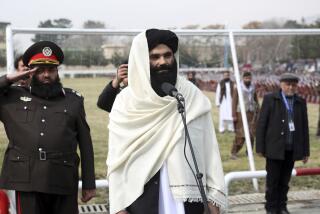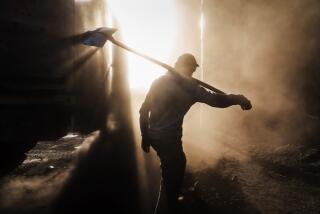Pushtuns Decry Warlordism in Power Structure
- Share via
SAMAL, Afghanistan — Here in the boulder-strewn mountains that rise like daggers and in the valleys that have barely a tree or green shrub, newly elected Afghan President Hamid Karzai and his government face their biggest test.
The loya jirga, or grand council, that elevated Karzai from interim leader to the post of transitional president and saw the naming of a Cabinet is barely over. But a number of people here in southeastern Afghanistan are already voicing frustration.
“I am disappointed because, in the six months that Karzai was interim head of the government, he promised to disarm people and get rid of warlordism, but his words were never put into practice,” said Han Mohammed, who runs a gas station about a five-hour drive south of Kabul, the capital, on a gravel road in this village. “If he doesn’t take action, he will lose his fame and the people will desert him.”
This is Afghanistan’s wild southeastern tier, its so-called Pushtun Belt, a group of provinces that border Pakistan. The area is dominated by the Pushtun ethnic group, which has long been fiercely independent.
It is a region that Karzai’s government must attend to both because Pushtuns make up the largest ethnic group in the country and because they have the capacity to destabilize Afghanistan if they are not pleased. The Taliban regime was championed in the mid-1990s by Pushtuns fed up with the chaos caused by warring commanders in the center of the country.
So far, hardly anyone has been appointed from this region to a major position in Kabul, with the exception of the former governor of Paktia, Taj Mohamad Wardak. However, Wardak had lived for 15 years in Los Angeles until only a few months ago, so many do not view him as a native.
“This is just a transitional government. This is just for the time being,” said Tela Khan, 40, a shopkeeper in the small village of Saparai, eager to underscore that Pushtuns will not have to put up permanently with what he sees as the inferior role assigned to them. “It is just an 18-month government. Then there will be another loya jirga, and then power will be equally distributed among all the [ethnic] groups.”
Although relatively little is known in these remote reaches of the country about what happened at this month’s loya jirga, a few key points--some only partially accurate--have come across. The lack of reliable information is a byproduct of Afghanistan’s extreme poverty and underdevelopment. There is virtually no television here. Information is limited to what crackles over the BBC radio’s Pashto-language broadcast in the evenings and to word of mouth.
It is widely believed that Pushtuns were slighted in the allocation of Cabinet posts and that all the key jobs went to ethnic Tajiks from the Panjshir Valley in northeastern Afghanistan. It is also believed that Karzai caved in to the warlords, including them in his Cabinet and, according to local logic, by doing so augmented their power.
While it is true that Tajiks from the Panjshir Valley maintained their grip on some of the most powerful ministries, there also are Pushtuns and ethnic Hazaras in a number of key posts. Karzai’s dance with the warlords, however, is a dicier matter. It remains to be seen whether his strategy of attempting to include them in his Cabinet will loosen their hold on the regions or increase their profile and ability to wield power.
“There was no benefit to us Pushtuns,” said Naeem, a farmer in the city of Gardez who, like many Afghans, goes by one name. “We were not given anything in the Cabinet. And Hamid Karzai cannot use his power. He is just trying to keep the situation in balance. But the fighting and bombing is finished, so we are very happy about that.”
In a nearby pharmacy, a group of men discussing the loya jirga agreed that security had been better under the Taliban but that the real problem with the new government is the inclusion of warlords.
“It was not a good decision of Karzai’s to include the warlords,” said Nak Mohammed, the pharmacy owner. “When Karzai first took over the government, he promised he would eliminate warlordism, but he has not and now they are stronger.”
The more educated the person, the more disappointed he or she seems to feel. Educated people especially had hoped Karzai would build a Cabinet of professionals rather than making political choices.
“It would have been better to spend all the money they spent on the loya jirga on rebuilding the country,” said Sakhi Mirrullah, an engineer with CARE, an international nongovernmental organization. “The loya jirga was an opportunity for Karzai to select experienced people for his government. Afghanistan needs people with experience in all fields. We do not need warlords.”
Shaping people’s views the most, however, is the issue of personal safety. Notably in the populous Khowst region near the Pakistani border, law and order appear to have broken down altogether. As a result, it is difficult for residents to believe that there is a central government at all. They have a generally good feeling about Karzai but paid minimal attention to the recent events in Kabul.
Their lack of interest is hardly surprising. On Monday in the town of Khowst, the light pop, pop, pop of automatic weapon fire shattered the sultry afternoon. A man, his dark hair flowing to his shoulders, stood in a field near the main city hospital and fired at vehicles on the nearby road. A second man seemed to be firing as well.
Other armed men fired back. Moments later, one of the men was injured, another captured, the firing stopped, and traffic, which had come to a standstill, resumed.
According to locals, this was a minor event but emblematic of the uncertainty in the city. Indeed, all the talk is of shootings, car thefts kidnappings and killings.
“No. 1, we want safety. Then we can talk about reconstruction and rebuilding,” said Sher Abbad, who works in the Khowst governor’s office.
More to Read
Sign up for Essential California
The most important California stories and recommendations in your inbox every morning.
You may occasionally receive promotional content from the Los Angeles Times.













